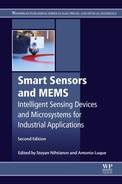Table of Contents
1. What makes sensor devices and microsystems “intelligent” or “smart”?
1.2. Interpretation of terms related to sensors
1.3. Key trends in the development of sensors (sensor devices) and microelectromechanical systems
2. Interfacing sensors to microcontrollers: a direct approach
Sources of further information and advice
3. Smart temperature sensors and temperature sensor systems
3.3. Temperature-sensing elements
3.4. Basic concepts of smart temperature sensors
3.5. Methods to improve the accuracy of CMOS smart temperature-sensor systems
3.6. Principles of BJT-based smart temperature sensors with DCM
3.7. Signal processing of duty cycle modulated signals
3.8. Fabrication and test results
4. Capacitive sensors for displacement measurement in the subnanometer range
4.2. Challenges for subnanometer displacement measurement with capacitive sensors
4.3. Offset capacitance cancellation technique
4.4. Capacitance-to-digital converter with offset capacitance cancellation and calibration functions
5. Integrated inductive displacement sensors for harsh industrial environments
5.1. Why inductive displacement sensors?
5.2. Principle of operation and practical limitations for eddy-current sensors
5.3. Design requirements in precision industrial applications
5.4. State-of-the-art eddy-current sensor interfaces
5.5. Eddy-current sensor interfaces with LC oscillator and ratiometric measurement
5.6. Summary and design perspectives
6. Magnetic sensors and industrial sensing applications
7.2. Challenges for radiation detection in the VUV and EUV spectral ranges
7.3. Device solutions for radiation detection in the VUV and EUV spectral ranges
7.4. Methods of radiometric investigation and characterization
7.5. Spectral responsivity and radiation hardness of VUV and EUV radiation detectors
8. Advanced interfaces for resistive sensors
8.3. Voltamperometric resistance estimation
8.4. Resistance-to-time conversion methods
8.5. Industrial-related aspects
8.6. Conclusion and future trends
9.2. Fundamentals of ultrasonic sensing and pulse-echo measurements
9.3. Reconfigurable ultrasonic smart sensor platform design
9.4. Algorithms used in evaluation of reconfigurable ultrasonic smart sensor platform
9.8. Sources of further information and advice
10. Advanced Optical Incremental Sensors: Encoders and Interferometers
10.2. Displacement interferometers
10.3. Sources of error and compensation methods
10.6. Current and future trends
11. Microfabrication technologies used for creating smart devices for industrial applications
11.2. Microelectromechanical systems design and modeling
11.4. Microfabrication processes
12. Microactuators: Design and Technology
12.2. Considerations in mechanisms selection
13.3. Components of a microfluidic system
14. Dynamic behavior of smart microelectromechanical systems in industrial applications
14.2. Resonant frequency response of smart microelectromechanical systems vibrating structures
15. Microelectromechanical systems integrating motion and displacement sensors
15.2. Technical description of MEMS motion sensors: MEMS accelerometer
15.3. Microelectromechanical systems gyroscope
15.4. Microelectromechanical systems magnetometer
15.5. Conclusion and future trends
16. Microelectromechanical systems print heads for industrial printing
16.2. Electrohydrodynamic print head droplet ejection
16.3. Electrohydrodynamic smart printing system
16.4. Case study: electrohydrodynamic printing applications
17. Photovoltaic and fuel cells in power microelectromechanical systems for smart energy management
17.2. Photovoltaic mini-generators
17.3. Applications of photovoltaic mini-generators
17.5. Applications of microfuel cells
17.6. Smart energy management with sun sensors
18. RF-MEMS for smart communication systems and future 5G applications
18.2. Evolution of RF-MEMS and of market expectations
18.3. RF-MEMS in the emerging 5G scenario
18.4. RF-MEMS technology: a general overview
18.5. RF-MEMS technology for capacitive microdevices
18.6. RF-MEMS technology for ohmic microdevices
18.7. RF-MEMS-based circuits for smart communication systems
18.9. RF-MEMS power capability
18.10. Cointegration of RF-MEMS-based circuits with integrated circuits
19. Smart acoustic sensor array system for real-time sound processing applications
19.2. Microelectromechanical systems microphones
19.3. Fundamentals of acoustic sensor arrays and applications
19.4. Design and implementation of smart acoustic microelectromechanical systems array
19.5. System implementation of AMA and CAPTAN
19.6. Smart acoustic sensor array system operation
19.7. Smart acoustic sensor array system calibration
19.8. Sensor array for time-of-flight measurements
19.9. 3D sound source localization
19.10. Smart acoustic sensor array system for mapping of the heart sound
